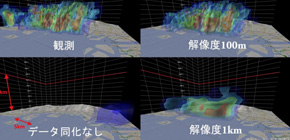
Local heavy rainfall prediction using cutting-edge weather radar and K supercomputer
Realization of big data assimilation leading to weather forecast revolution
In recent years, local heavy rainfall has been on the rise. It greatly influences daily lives and the social economy, causing disasters that claim people’s lives. Weather simulation by supercomputers updates new observation data hourly at 1 km grid spacing. However, during local heavy rainfall, cumulonimbus clouds generate and develop in only a couple of minutes, making them difficult to predict through hourly updated systems. Additionally, it was impossible to fully resolve cumulonimbus clouds causing local heavy rainfall at a grid spacing of 1 km or lower.
High-definition simulation at an extraordinary grid spacing of 10 m or 100 m using a K supercomputer has made it possible to simulate each cumulonimbus cloud causing local heavy rainfall in detail. Furthermore, the Phased Array Weather Radar, whose operation was started in the summer of 2012 at Osaka University, has enabled close detection of an area with a 60 km-radius at a resolution of 100 m within 30 seconds as well as accurate observation of dynamic movements of local heavy rainfall.
An international joint group of researchers led by Team Leader MIYOSHI Takemasa of RIKEN's Data Assimilation Research Team at the Advanced Institute for Computational Science, along with the National Institute of Information and Communications Technology (NICT), and Osaka University, developed a local heavy rainfall forecast method by using the most-advanced weather radar and a K supercomputer.
Integrating big data obtained at a high-speed by the K supercomputer at RIKEN and the state-of-the-art Phased Array Weather Radar developed by NICT and Osaka University, this joint international group succeeded in achieving spatiotemporal weather forecast simulation, which is capable of updating by getting observation data at 100-m grid spacing every 30 seconds, reproducing real local heavy rainfall movement in detail.
The foundation of the weather forecast is a data assimilation (DA) method which integrates computer simulations and real-world observations. Using innovative technology combining next-generation simulation with a high-definition sensor, this group achieved big data assimilation (BDA) technology capable of using unprecedented big data. Data assimilation at 100-m grid spacing every 30 seconds was achieved by this group for the first time. Using this technology will make it possible to provide weather forecasts at unimaginably high levels of speed and accuracy, causing a revolution in weather forecasting.
Abstract
Sudden local severe weather is a threat, and we explore what the highest-end supercomputing and sensing technologies can do to address this challenge. Here we show that using the Japanese flagship “K” supercomputer, we can synergistically integrate “big simulations” of 100 parallel simulations of a convective weather system at 100-m grid spacing and “big data” from the next-generation phased array weather radar that produces a high-resolution 3-dimensional rain distribution every 30 s—two orders of magnitude more data than the currently used parabolic-antenna radar. This “big data assimilation” system refreshes 30-min forecasts every 30 s, 120 times more rapidly than the typical hourly updated systems operated at the world’s weather prediction centers. A real high-impact weather case study shows encouraging results of the 30-s-update big data assimilation system.

Figure 1. Distribution of thunderclouds on September 11, 2014
Top left: Observational data from the phased array weather radar
Bottom left: The simulation without integration of observational data
Top right: Results of a simulation with big data assimilation on a 100-meter grid
Bottom right: Results of a simulation with data assimilation on a 1-kilometer grid
--
To learn more about this research, please view the full research report entitled “ Big Data Assimilation”Revolutionizing Severe Weather Prediction ” at this page of the American Meteorological Society website.
Related link

